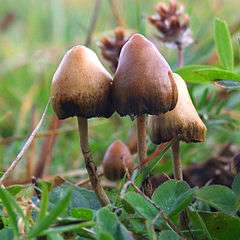Fungi in human culture
.jpg)
Fungi play a variety of roles in human culture. Yeasts have been used since ancient times to leaven bread and to ferment beer and wine. More recently, mould fungi have been exploited to create a wide range of industrial products, including enzymes and drugs. Medicines based on fungi include antibiotics, immunosuppressants, statins and many anti-cancer drugs. The yeast species Saccharomyces cerevisiae is an important model organism in cell biology.
The fruiting bodies of some larger species are collected as edible mushrooms, including delicacies like the chanterelle, cep, and truffle, while a few species are cultivated. Mould fungi provide the meaty (umami) flavour of fermented soybean products such as tempeh, miso and soy sauce, and contribute flavour and colour to blue cheeses such as Roquefort and Stilton. Moulds also yield vegetarian meat substitutes such as Quorn.
Some fungi such as the fly agaric and psilocybin mushrooms are used for the psychoactive drugs that they contain; these in particular are the focus of academic study in the field of ethnomycology.
Fermentation
Yeasts have been used since ancient times to leaven bread and to ferment beer and wine.[1] More recently, fungi have been used for a wide variety of industrial fermentations, whether working directly for their effects on materials such as processing paper pulp or bioremediating industrial waste, or serving as the source of enzymes for many purposes, such as fading and softening denim for fashionable blue jeans.[2] Fungi yield a wide variety of industrial enzymes including amylases, invertases, cellulases and hemicellulases, pectinases, proteases, laccases, phytases, alpha-glucuronidases, mannanases, and lipases.[3]
Food

The fruiting bodies of many larger fungi such as the chanterelle and the cep are collected as edible mushrooms.[4][5] Some, such as truffles, are esteemed as costly delicacies.[6] A few species such as Agaricus bisporus and oyster mushrooms (Pleurotus spp.) are cultivated.[7]
Mould fungi are the source of the meaty (umami) flavour of the soybean products tempeh, miso and soy sauce. Moulds contribute the blue coloration and much of the flavour in blue cheeses such as Roquefort and Stilton.[8] Mould fungi are processed to produce vegetarian meat substitutes such as Quorn.[2]
In medicine

Fungi are the sources of many types of medicinal drug including antibiotics, immunosuppressants, and statins. Major classes of antibiotics, the penicillins and the cephalosporins, are derived from substances produced by fungi. So also are the immunosuppressant macrolides, the cyclosporins.[2]
The cholesterol-lowering drugs, the statins, were initially produced by fungi including Penicillium. The first commercial statin, lovastatin, was fermented by the mould Aspergillus terreus.[9][10]
Numerous anti-cancer drugs such as the mitotic inhibitors vinblastine, vincristine, podophyllotoxin, griseofulvin, aurantiamine, oxaline, and neoxaline are produced by fungi.[11][12]
In science
The yeast species Saccharomyces cerevisiae is an important model organism in modern cell biology, and is one of the most thoroughly researched eukaryotic microorganisms.[13] It was the first eukaryote whose genome was sequenced.[2]
In religion, art, and witchcraft

Some species such as the fly agaric and psilocybin mushrooms are used for the psychoactive drugs that they contain.[14] These are the focus of academic study and intense debate in the field of ethnomycology. In the 1950s, the American banker Robert Gordon Wasson participated in a Mazatec psilocybin mushroom ritual, and wrote an influential but controversial book claiming that the Soma mentioned in the Rigveda was Amanita muscaria, the fly agaric.[lower-alpha 1][16][17][15] The mycologist John Ramsbottom however confirmed one element that Allegro later wove into his theory, stating in 1953 that the tree of the knowledge of good and evil fresco[lower-alpha 2] in the Plaincourault Chapel depicted Amanita muscaria.[lower-alpha 3][18] The ergot fungi whose sclerotia appear as "black grain" in rye and other cereals are implicated in the witch trials of 17th century Norway. The hallucinations caused by ergotism, with visions of Satan as a black dog or cat, caused people to be accused of witchcraft. People in other cultures such as the Aztecs brewed drinks with ergot, which contains alkaloids based on lysergic acid.[19][20]
Notes
- ↑ Michael Hoffman wrote: Wasson neglects to address the relevant question of whether the tree of life at the end of the Bible meant Amanita mushrooms. He asserts that the tree of life in Genesis meant Amanita, while implying that the tree of life in Revelation did not mean Amanita – an unlikely combination of ideas, which he fails to address and justify.[15]
- ↑ The Plaincourault Chapel fresco of the tree of the knowledge of good and evil has been photographed in detail on Flickr by Giorgio Samorini.[18]
- ↑ Ramsbottom wrote: "The Fly-Agaric is one of the easiest fungi to recognise and to describe. Consequently its poisonous properties were early known ... In a fresco in a ruined chapel at Plaincourault (Indre, France), dating from 1291, a branched specimen is painted to represent the tree of good and evil (Pl. Ib, pg. 34). Presumably it was the artist's conception of the essence of evil made more terrible by enlargement and proliferation. The serpent is shown winding round the stem, offering the traditional apple to Eve, who, apparently having eaten of the 'tree', is shown in an attitude which suggests that she is 'suffering from colic rather than from shame'."[18]
References
- ↑ Legras JL, Merdinoglu D, Cornuet JM, Karst F. (2007). "Bread, beer and wine: Saccharomyces cerevisiae diversity reflects human history". Molecular Ecology. 16 (10): 2091–2102. doi:10.1111/j.1365-294X.2007.03266.x. PMID 17498234.
- 1 2 3 4 "The importance of fungi". Royal Botanic Gardens Kew. Retrieved 4 November 2016.
- ↑ De Lourdes, Maria; Polizeli, T. M.; Rai, Mahendra (2013). Fungal Enzymes. CRC Press. ISBN 978-1-4665-9454-8.
- ↑ Hall IR, Lyon AJ, Wang Y, Sinclair L (1998). "Ectomycorrhizal fungi with edible fruiting bodies 2. Boletus edulis". Economic Botany. 52 (1): 44–56. doi:10.1007/BF02861294.
- ↑ Persson O. (1997). The Chanterelle Book. Berkeley, California: Ten Speed Press. ISBN 0-89815-947-4.
- ↑ Brillat-Savarin, Jean Anthelme (1838) [1825]. Physiologie du goût. Paris: Charpentier. English translation
- ↑ "Making Money by growing Mushrooms" (PDF). Food and Agriculture Organization of the United Nations. Retrieved 18 July 2016.
- ↑ Kinsella, J.E.; Hwang, D.H. (November 1976). "Enzymes of Penicillium roqueforti involved in the biosynthesis of cheese flavour". CRC Crit Rev Food Sci Nutr. 8 (2): 191–228. doi:10.1080/10408397609527222. PMID 21770.
- ↑ Tolbert, Jonathan A. (2003). "Lovastatin and beyond: the history of the HMG-CoA reductase inhibitors". Nature Reviews Drug Discovery. 2: 517–526. doi:10.1038/nrd1112. PMID 12815379.
- ↑ Jahromi, M.F.; Liang, J.B.; Ho, Y.W.; Mohamad, R.; Goh, Y.M., Shokryazdan, P. (2012). "Lovastatin production by Aspergillus terreus using agro-biomass as substrate in solid state fermentation.". Journal of Biomedical Biotechnology. 2012: 196264. doi:10.1155/2012/196264. PMC 3478940
 . PMID 23118499.
. PMID 23118499. - ↑ Nicoletti, Rosaria; Ciavatta, Maria Letizia; Buommino, Elisabetta; Tufano, Maria Antonietta (2008). "Antitumor extrolites produced by Penicillium species" (PDF). International Journal of Biomedical and Pharmaceutical Sciences. 2 (1): 1–23. Archived from the original (PDF) on 26 December 2014.
- ↑ "Antitumor extrolites produced by Penicillium species" (PDF). Archived from the original (PDF) on 26 December 2014.
- ↑ Ostergaard S, Olsson L, Nielsen J. (2000). "Metabolic Engineering of Saccharomyces cerevisiae". Microbiology and Molecular Biology Reviews. 64 (1): 34–50. doi:10.1128/MMBR.64.1.34-50.2000. PMC 98985
 . PMID 10704473.
. PMID 10704473. - ↑ Guzmán G. (2008). "Hallucinogenic mushrooms in Mexico: An overview". Economic Botany. 62 (3): 404–412. doi:10.1007/s12231-008-9033-8.
- 1 2 Hoffman, Michael (2006). "Wasson and Allegro on the Tree of Knowledge as Amanita". Retrieved 4 November 2016.
- ↑ In 1970, the philologist John Allegro destroyed his career by claiming that the fly agaric was the main focus of worship in the more esoteric sects of Sumerian religion, Judaism and early Christianity.Wasson, R. Gordon (1968). Soma: Divine Mushroom of Immortality. ISBN 0-15-683800-1.
- ↑ Allegro, John (1970). The Sacred Mushroom and the Cross: The Study of the Nature and Origins of Christianity Within Fertility Cults of the Ancient Near East. Hodder & Stoughton. p. 320. ISBN 0-340-12875-5.
- 1 2 3 Ramsbottom, John (1953). Mushrooms & Toadstools. Collins New Naturalist. p. 46.
- ↑ Alm, T. (2003). "The Witch Trials of Finmark, Northern Norway, During the 17th Century: Evidence for Ergotism as a Contributing Factor". Economic Botany. 57 (3): 403–416.
- ↑ "Ethnomycology". University of East Anglia. Retrieved 4 November 2016.

